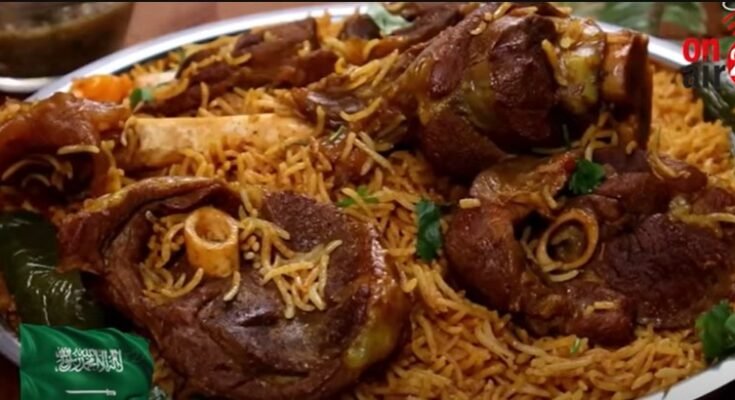Saudi Arabian cuisine is a vibrant tapestry of flavors, aromas, and textures that reflect the country’s rich cultural heritage and warm hospitality. From hearty rice dishes to delectable street food and sweet desserts, Saudi Arabia offers a diverse culinary landscape that’s sure to tantalize your taste buds. Join us as we explore 10 iconic dishes that showcase the best of Saudi Arabian gastronomy.
Kabsa: The National Treasure
Our culinary expedition begins with Kabsa, the national dish of Saudi Arabia. This aromatic masterpiece perfectly encapsulates the warm hospitality and diverse flavors of the region. Kabsa features fragrant long-grain rice cooked to perfection with a symphony of spices, creating a delightful canvas for succulent meat.
Traditionally, Kabsa is prepared with lamb, but variations with chicken or fish are also popular. The dish’s complex flavor profile comes from a blend of spices that may include cardamom, saffron, cinnamon, black lime, bay leaves, and nutmeg. The meat is often cooked separately and then laid on top of the rice, allowing its juices to infuse the grains with additional flavor.
Fun fact: Kabsa is so beloved in Saudi Arabia that it’s often referred to as “machboos” in the eastern regions of the country.
Mandi: Slow-Cooked Perfection
Next on our list is Mandi, a culinary marvel that showcases the art of slow-cooking. This dish pairs seasoned rice with tender meat, often lamb or chicken, creating a symphony of flavors that exemplify the heart and soul of Arabian cuisine.
Mandi’s unique cooking method involves using a tandoor oven, where the meat is suspended over the rice, allowing its juices to drip down and flavor the grains. The result is a smoky, aromatic dish that’s both comforting and indulgent.
Did you know? The word “mandi” comes from the Arabic word “nada,” which means “dew,” referring to the dewy tenderness of the meat.
Shawarma: Street Food Sensation
No culinary journey through Saudi Arabia would be complete without mentioning Shawarma. This beloved street food has gained international fame for good reason. Thinly sliced seasoned meat, often chicken or beef, is slowly roasted on a vertical spit and then shaved off to order.
The meat is typically wrapped in warm pita bread and accompanied by a variety of toppings, including garlic sauce, tahini, pickles, and fresh vegetables. The result is a portable, flavorful meal that’s perfect for on-the-go eating.
Interesting statistic: It’s estimated that over 2 million shawarma sandwiches are consumed daily across the Middle East.
Harees: A Historical Delicacy
Harees is a dish with deep historical roots in Saudi Arabian cuisine. This comforting, porridge-like dish marries crushed wheat and meat, often chicken or lamb, slow-cooked to achieve a unique texture. The simplicity of its ingredients belies the complexity of its flavors, making it a staple during Ramadan and other special occasions.
The preparation of Harees is a labor of love, often taking hours to achieve the perfect consistency. The wheat and meat are cooked together until they form a thick, creamy mixture, which is then seasoned with ghee, cinnamon, and sometimes a sprinkle of sugar.
Historical tidbit: Harees is mentioned in early Islamic literature, with some sources dating it back to the 10th century.
Mutabbaq: A Handheld Delight
Mutabbaq brings a satisfying crunch to our culinary adventure. This delightful stuffed pastry showcases Saudi Arabia’s prowess in creating diverse flavors within a single handheld delight. The thin, crispy dough can be filled with a savory mixture of minced meat and vegetables or sweet delights like dates or banana and honey.
The versatility of Mutabbaq makes it a popular choice for both snacks and light meals. Its portability has also contributed to its popularity as a street food item in many parts of Saudi Arabia.
Sambousak: Crispy Flavor Bombs
Crispy and bursting with flavor, Sambousak steals the show in many Saudi households. These deep-fried or baked pastries are generously filled with spiced meat, cheese, or vegetables. The perfect balance of textures and tastes makes Sambousak a beloved snack or appetizer.
The origins of Sambousak can be traced back to the ancient Persian Empire, from where it spread across the Middle East and beyond. Today, variations of this dish can be found in cuisines around the world, from Indian samosas to Latin American empanadas.
Falafel: Vegetarian Delight
No culinary exploration of Saudi Arabia would be complete without mentioning Falafel. These golden-brown chickpea or fava bean patties have gained global acclaim for their irresistible blend of textures and tastes. Typically served in pita bread with tahini sauce and fresh vegetables, Falafel offers a delicious vegetarian option in a cuisine that often emphasizes meat dishes.
While not originally Saudi, Falafel has been embraced by the local cuisine and is widely available throughout the country. Its popularity extends beyond vegetarians, with many meat-eaters enjoying it as a lighter alternative to meat-based dishes.
Nutritional note: Falafel is high in protein, fiber, and various vitamins and minerals, making it a nutritious choice for those looking to incorporate more plant-based meals into their diet.
Madfoon: Underground Barbecue
Madfoon, the outdoor cooking masterpiece, adds a smoky twist to our journey. This dish involves marinating meat (usually chicken or lamb) and slow-cooking it in an underground oven, infusing it with a distinct flavor. Madfoon showcases Saudi Arabia’s love for barbecue, combining simplicity with robust tastes.
The underground cooking method used for Madfoon is similar to the Hawaiian luau or the New Zealand hangi, demonstrating how cultures around the world have developed similar cooking techniques independently.
Ruz Bukhari: Aromatic Rice Dish
Ruz Bukhari is a flavorful Saudi Arabian rice dish that’s gained popularity throughout the kingdom. Made with fragrant basmati rice, black lentils, caramelized onions, and a blend of aromatic spices, this dish is cooked until the rice is fluffy and the flavors are well-blended.
The dish is believed to have originated from the Bukhari community, who migrated from Central Asia to Saudi Arabia, bringing with them their culinary traditions. Today, Ruz Bukhari is enjoyed by families across Saudi Arabia as a comforting and satisfying meal.
Kunafa: Sweet Finale
Our culinary expedition concludes on a sweet note with Kunafa. This divine dessert features thin, noodle-like pastry soaked in sugar-based syrup, often layered with cheese or nuts. Kunafa tantalizes taste buds with its contrasting textures, offering a perfect ending to any Saudi Arabian feast.
While Kunafa is popular throughout the Middle East, each region has its own variation. In Saudi Arabia, it’s often served during Ramadan and special occasions, sometimes topped with pistachios or drizzled with additional syrup.
Conclusion:
Saudi Arabian cuisine is a testament to the country’s rich cultural heritage, blending traditional cooking methods with a diverse array of ingredients and flavors. From the national dish Kabsa to the street food favorite Shawarma, and the sweet indulgence of Kunafa, each dish tells a story of tradition, hospitality, and culinary innovation.
As Saudi Arabia continues to open its doors to international tourism, its cuisine is gaining recognition on the global stage. Whether you’re planning a visit to the kingdom or simply want to expand your culinary horizons, exploring these ten dishes offers a tantalizing glimpse into the flavors of Saudi Arabia.



